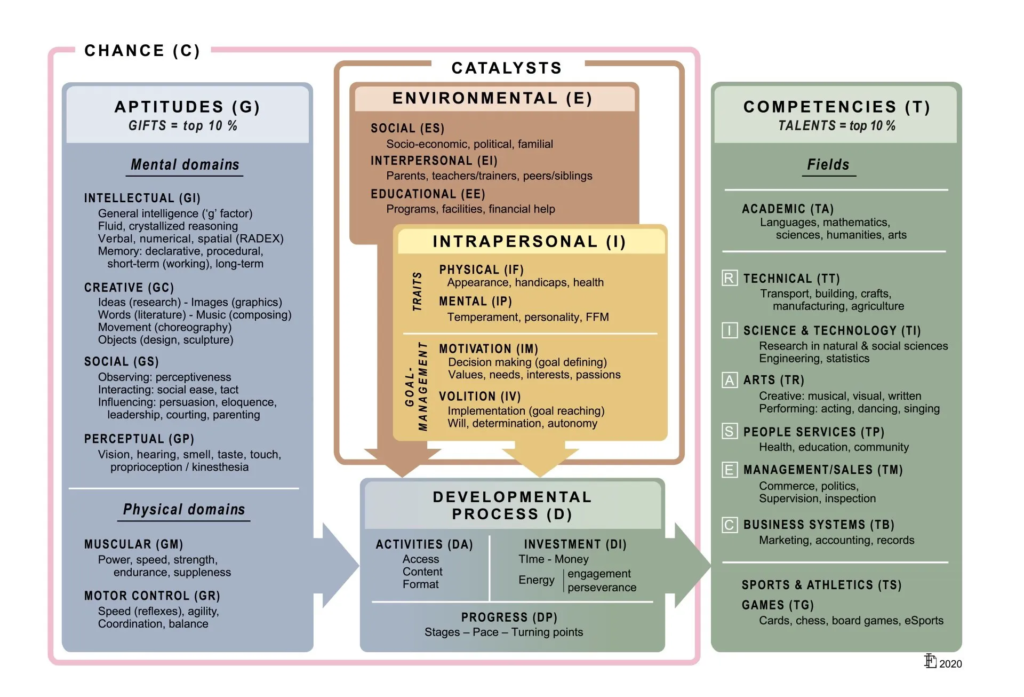Giftedness Explained
Definition and Prevalence

The general accepted definition of giftedness is not concrete, and criteria for giftedness can differ across educational systems. Australia generally uses Canadian psychologist Françoys Gagné’s Differentiating Model of Giftedness and Talent, which defines giftedness as the possession of natural abilities within the top 10% of a person’s age group (Australian Association for the Education of the Gifted and Talented, n.d.-a). It is therefore estimated that around 404,251 of the 4,042,512 students in Australia as of 2022 (Australian Bureau of Statistics, 2023) can be classified as gifted in some way.
While this website primarily focuses on intellectual giftedness, giftedness can occur in other domains like creativity. As seen in the above image, Gagné’s model makes an important distinction between giftedness and talent: giftedness describes natural abilities significantly above the expected level for a person’s age, while talent involves performance at a level significantly above what is expected of them. This relies upon a child’s development catalysts like motivation, educational access, parenting, and more. Therefore, a child might be born gifted, but without the proper environment for growing their talents their natural abilities might never be fully realised (Gagné, 2000).
Traits of Giftedness
Intellectually gifted children exhibit significantly higher intelligence than their peers and will think and reason at a level far beyond their physical age. Each gifted child is unique and may exhibit any combination of the following traits in varying levels (Bainbridge, 2021; Klein, 2023; Queensland Association for Gifted and Talented Children, n.d.):
- Rapid learning
- Highly sensitive, with intense emotions and reactions
- High curiosity and desire for learning
- Develops reading abilities before entering school
- Capable of abstract reasoning and thinking more than their peers
- Strong sense of social justice
- Highly knowledgeable on topics they are passionate about
- Developed sense of humour
- Unique imagination
- Superior vocabulary
- Prefers individual work to group work
- Thrives on challenge
- Developed ability to work independently
- May develop single-mindedness in areas of interest that can be difficult to redirect
- Relates to older children and adults more than age peers
The following brief video from psychologist Dr. Dan Peters (2012) explores some of these traits a little further:
Intelligence Quotient (IQ) is a key component of intellectual giftedness. It is a measure of a range of areas including language, mathematics, reasoning, and more (Legg, 2020). Your IQ remains approximately consistent from childhood to adulthood, and as such it is intended as a measure of mental ability rather than knowledge. The average IQ is 100. The Davidson Institute (2021) explains that there are 4 levels of giftedness according to IQ.
Mildly Gifted: 115 – 130 IQ
Moderately Gifted: 130 – 145 IQ
Highly Gifted: 145 – 160 IQ
Profoundly Gifted: 160+ IQ
The IQ of children can be measured using an IQ test, of which there are several. According to the Australian Association for the Education of the Gifted and Talented (n.d.-b), the Stanford-Binet V (age 2 – 85+), Weschler Intelligence Scale for Children WISC-V (age 6 – 16), and Wechsler Preschool and Primary Scale of Intelligence WPPSI-IV (age 2 – 7) are commonly used in Australia. These are psychological assessments that can be administered by a registered psychologist.
Factors in the Development of Giftedness
Intellectual giftedness is a complex phenomenon that is influenced my numerous factors. Genetics has a considerable impact on intelligence, although the exact percentage of this influence varies from study to study. According to the University of Edinburgh (2021), studies on twins have placed this influence between 50% – 80%, while studies on unrelated people suggest an influence closer to 30% resulting in the “mystery of the missing heritability”. Nevertheless, we know genetics does play a role. We also know that the genetic influence on intelligence is actually weaker for children than adults. One study of 11,000 pairs of twins by Haworth et al. (2009) found a linear increase of 41% genetic influence in childhood (9 years) to 55% in adolescence (12 years) and to 66% in young adulthood (17 years).
While genetic factors influence whether or not a child may be born gifted, many environmental and intrapersonal factors are critical in the development of giftedness as demonstrated by Gagné’s model. As a teacher, you have an invaluable role in the development of gifted students, as will be discussed further on the Teaching Gifted page.
A gifted child’s parents or caregivers play a major role in this. Gifted children with parents who are confident in them, supportive of their interests, and offer an appropriate level of autonomy are more likely to thrive than those with parents who do not respect their intelligence and/or force an overly authoritarian parenting style on the child (Yildiz and Altay, 2021). Socioeconomic status also plays a part. Wealthier families have easier access to gifted programs and activities for their gifted children than poorer families who may not be able to afford these programs (Balam, 2009). Wealthier families may also have a better understanding of educational systems than poorer families, and as such can better advocate for their gifted child using this understanding (Grissom et al., 2019). Finally, like any child, gifted children can also have neurodevelopmental disorders such as ADHD, dyslexia, and others. These gifted children are known as “twice-exceptional” (Arky, 2023). Without a developed understanding of giftedness, these disorders can cause twice-exceptional students to be overlooked by teachers because of their apparent learning difficulties. In order for these children to succeed, they need support for their learning difficulties as well as their giftedness (Laningham and Holman, 2023). It’s important to note that some symptoms of giftedness may lead to misdiagnosis of disorders. For example, distractability in class may actually point to a gifted student not being challenged enough rather than a symptom of ADHD. The help of a psychologist where possible can be very useful in identifying those that are truly twice-exceptional and developing programs that can support those students, though even some psychologists may struggle to distinguish giftedness and twice-exceptionality due to the general lack of training and understanding around giftedness (Webb et al., 2019).
There are many other factors that might impact the development and manifestation of giftedness, though these are some key influences. For gifted students to successfully develop their gifts into talents, they rely on the people and environment around them to provide them with the opportunities and nurturing they need.
Key Pages
Giftedness Explained
Learn about giftedness, its prevalence, traits, and factors that contribute to its development
Teaching Gifted
Learn about the classroom needs of gifted students, underachievement, and their social needs
Resources
A wide array of resources to assist you in teaching gifted students and empowering them


